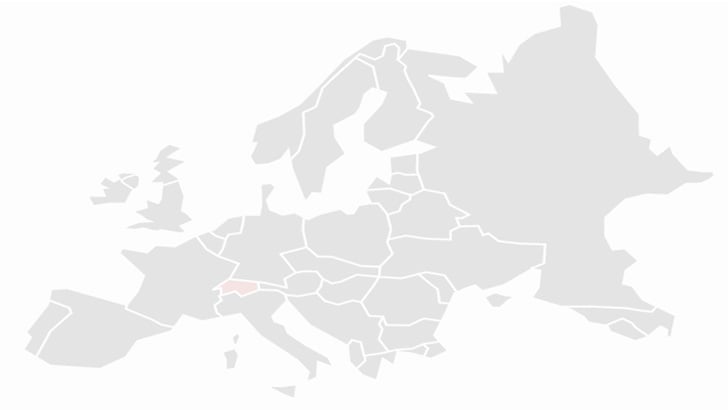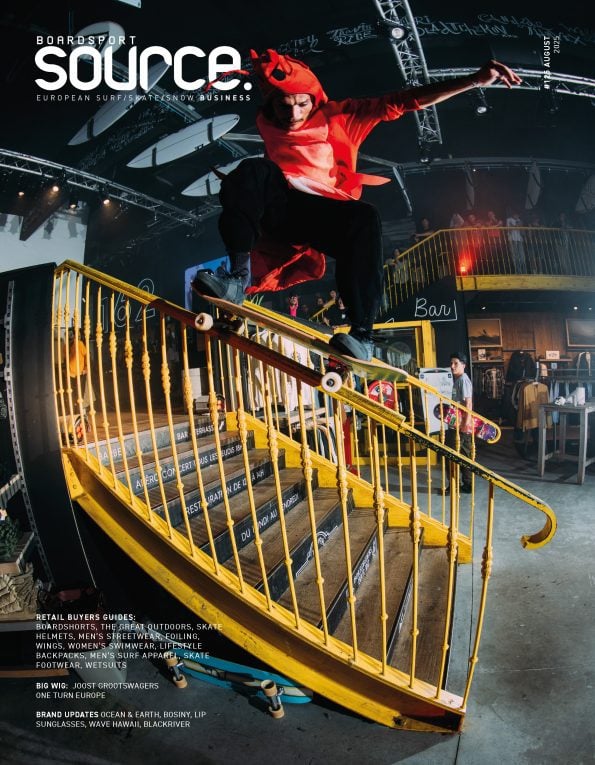
Swiss Market Insight July 2019 (ENG, FR & GER Versions)
Summer products in Switzerland are divided into three main categories: streetwear/footwear, skateboarding and watersports. It’s not unusual that the three are all found under one roof but often one sector takes centre stage. Watersports are important in Switzerland but of course they are not the same or done in the same way as in countries with access to the sea or the ocean, but they are by no means left by the wayside either. Despite all that and although it might make some of our neighbours laugh, Switzerland with its rivers and lakes, is good for aquatic sports. It started with sailing, then windsurfing and now there is a growing interest in kitesurfing, foil and SUP. Not even surfing is neglected in Switzerland and the love for boardsports, travel and adventure, the three key ingredients to surfing, produces a constantly growing number of participants from our landlocked country. According to Simon Frei from Cloud 9 (shop and distributor in Winterthur), the progression in the surfing market in Switzerland can solidly back up this point. Cloud 9 is one of the main retailers of surf related products in Switzerland. They distribute the brands Rip Curl, FCS, Global Surf Industries and torq amongst others. The market is growing and demand is diversifying, and so is the choice of products. Cloud 9 have responded to this by enlarging their range as well as investing more in their stock to be able to meet this increasing demand. By Febien Grisel.

Surprisingly, even in the winter months sales are proving pretty impressive. Thanks to them and a few other shops and importers, it’s now possible to kit ourselves out for surfing from our own country. The prices are stable and similar to the Eurozone, there’s much less disparity than in snowboarding for example. These days, travelling to the ocean is not the only way for the Swiss to surf. River surfing as well as artificial waves like Oana in Ebikon, the Urban Surfwelle in Zurich and the two Wavegarden projects (Alaia and Wavup) are generating curiosity and new appeal for a sport that’s on the rise.
As for the skateboard market, its next step in maturity is proving difficult to predict. Back in the day, kids used to find a sport they liked and threw themselves, heart and soul into it, often developing into a passion or even a lifestyle without looking around too much at other opportunities open to them. It seems different these days; youngsters are more open to new things and to different ways of doing a sport and in our case, ways of skateboarding. What used to be limited to cutting your teeth on a sidewalk has now opened up to broader horizons; we have more kinds of terrain and more types of wheeled hardware to fully express yourself on. So what we call “softwheel skateboarding” has gained more and more enthusiasts in recent years, even reaching a peak in 2015, after which there was a sharp decline in the market. Since then the market has stabilised and the legitimate players have remained and some of the opportunists have disappeared. In order to limit the risks it seems obvious these days that product diversification is essential to the survival of specialist shops. By offering a maximum amount of choice, you can better meet the variety of demand at the same time as minimising the shock when a product runs out of steam. Jeremy Sochin from Number.One Boards and Bikes in Lucerne is an advocate of this strategy; he prioritises service, choice and product diversity over sales volumes of trendy products whose appeal could dwindle from one day to the next. He also pays special attention to being able to offer the most unique products to his customers. The brands Powell and Santa Cruz are the most mainstream brands in his range, all the other brands, like Welcome to name but one, are practically only available from him in Switzerland.
FRENCH
En Suisse, les produits d’été se divisent en trois catégories principales : le streetwear/footwear, le skateboard et le nautique. Il n’est pas rare que les trois soient réunies sous un même toit, mais il y a souvent un secteur sur lequel on met l’accent. En Suisse, les sports nautiques sont importants, évidemment ils ne sont pas tout à fait les mêmes ou pratiqués de la même façon que dans les pays ayant accès à la mer et à l’océan, mais ils ne sont tout de même pas en reste. Malgré tout, et bien que cela fasse rire certains de nos voisins, la Suisse, avec ses rivières et ses lacs, est propice aux sports nautiques. Cela commença par la voile, puis le windsurf et, désormais, il y a de plus en plus d’attrait pour le kite, le foil et le SUP. Le surf non plus n’est pas en reste en Suisse, en effet l’amour des Helvètes pour les sports de glisse, pour l’aventure et les voyages, trois ingrédients quasiment inhérents au surf en tant que tel, entraine une augmentation constante du nombre de pratiquants dans notre “landlocked country”. Selon Simon Frei, du magasin et distributeur, Cloud 9 à Winterthur, le développement du marché du surf en Suisse est bon et solide, pour reprendre ces mots. Cloud 9 est un des principaux revendeurs de produits liés au surf en Suisse. Il distribue, entre autres, les marques Rip Curl, FCS, Global Surf Industries et Torq. Le marché grandit et la demande se diversifie, du coup le choix de produits également. Cloud 9 s’est adapté à ça en élargissant sa gamme mais, aussi, en investissant davantage dans son stock afin de pouvoir répondre à la demande grandissante. Etonnamment, même pendant les mois d’hiver, les ventes sont plutôt réjouissantes. Désormais, grâce à eux et quelques autres magasins et importateurs, il est possible de s’équiper en matériel de surf dans notre pays. Les prix sont stables et similaires à ceux de la zone Euro, il y a beaucoup moins de disparité que dans le snowboard par exemple. Aujourd’hui, le voyage à l’océan n’est plus l’unique manière de surfer pour les Suisses. Le surf de rivière ainsi que les vagues artificielles, comme Oana à Ebikon, la Urban Surfwelle de Zürich ou les deux projets de Wavegarden (Alaia et Wavup), engendrent de la curiosité et un nouvel attrait pour ce sport en plein essor.
En ce qui concerne le marché du skate, on remarque la chose suivante. A l’époque, les kids trouvaient un sport qui leur plaisait et se jetaient corps et âme dans sa pratique, qui devenait souvent une passion voire un mode de vie, sans trop s’intéresser aux autres possibilités qui s’offraient à eux. Ça semble différent aujourd’hui, les jeunes sont plus ouverts aux nouveautés et aux différentes manières de pratiquer un sport et, dans notre cas, dans la manière de faire du skateboard. Celui qui, autrefois, se limitait parfois à s’acharner sur un trottoir semble être aujourd’hui ouvert à d’autres horizons, envisageant d’autres types de terrains puis d’autres d’engins à roulettes pour s’exprimer pleinement. Ainsi, ce que l’on appelle le “soft wheels skateboarding” fait de plus en plus d’adeptes ces dernières années, il a même connu un pic en 2015, après quoi le marché s’est fortement réduit. Depuis, le marché s’est stabilisé et les acteurs légitimes sont restés, alors que certains opportunistes ont disparu. Afin de limiter les risques, il semble aujourd’hui évident que la diversification des produits soit essentielle à la pérennité des magasins spécialisés. En effet, offrir un maximum de choix permet de mieux répondre aux différentes demandes mais, surtout, d’éviter les mauvaises surprises lorsqu’un produit est en perte de vitesse. Jeremy Sochin, de Number.One Boards and Bikes à Lucerne, est adepte de cette stratégie, il privilégie le service, le choix et la diversité des produits, aux grandes quantités de ventes d’un produit trendy dont l’attractivité pourrait disparaitre du jour au lendemain. Il apprécie tout particulièrement le fait de pouvoir offrir le produit le plus unique possible à son client. Les marques Powell et Santa Cruz sont les marques les plus “mainstream” de son assortiment, toutes les autres marques, comme Welcome, pour n’en citer qu’une, ne sont pratiquement trouvables que chez lui en Suisse.
GERMAN
In der Schweiz sind die Sommerprodukte in drei Hauptkategorien eingeteilt: Streetwear/Footwear, Skateboarding und Wassersport. Es ist nicht ungewöhnlich, dass man alle drei unter einem Dach findet, aber oftmals steht ein Sektor im Mittelpunkt. Wassersportarten sind wichtig in der Schweiz, doch werden diese natürlich nicht auf die gleiche Art und Weise praktiziert wie in Ländern mit Zugang zum Meer. Trotzdem sind diese nicht zu vernachlässigen, und auch wenn es einige unserer Nachbarn zum Lachen bringen könnte, ist die Schweiz mit seinen Flüssen und Seen ein guter Ort für den Wassersport. Alles nahm seinen Anfang mit dem Segeln, gefolgt vom Windsurfen und jetzt wächst das Interesse stetig an Kitesurfen, Foiling und SUP. Nicht einmal das Surfen wird in der Schweiz vernachlässigt und die Liebe für Boardsportarten, das Reisen und Abenteuer – die drei wichtigsten Zutaten fürs Surfen -, produzieren eine ständig wachsende Teilnehmeranzahl in unserem landumschlossenen Land.
Laut Simon Frei von Cloud 9 in Winterthur unterstützt die Entwicklung des Surfmarktes diesen Punkt. Cloud 9 ist einer der wichtigsten Händler von Surfprodukten in der Schweiz. Der Markt wächst, die Nachfrage ist differenziert und dementsprechend groß das Produktangebot. Cloud 9 bedient die wachsende Nachfrage mit einer größeren Auswahl ebenso wie einer verstärkten Investition in die Lagerbestände. Überraschenderweise sind die Verkaufszahlen sogar in den Wintermonaten beeindruckend. Dank Cloud 9 und einigen anderen Shops ist es uns jetzt möglich, uns im eigenen Land für das Surfen komplett auszustatten. Die Preise sind stabil und ähneln denen in der Eurozone, die Diskrepanz ist wesentlich geringer als zum Beispiel beim Snowboarding. Heutzutage ist eine Reise ans Meer nicht mehr die einzige Möglichkeit für die Schweizer zum Surfen. River Surfing und künstliche Wellen wie Oana in Ebikon, die Urban Surfwelle in Zürich und die zwei Wavegarden-Projekte (Alaia und Wavup) sorgen für Aufmerksamkeit und ziehen neue Teilnehmer für den sich im Aufschwung befindenden Sport an.
Was den Skateboard-Markt angeht, ist es schwierig die Zukunft vorauszusagen. Als die Kids früher einen Sport entdeckten, den sie mochten, widmeten sie sich diesem mit Herz und Seele. Oft wurde daraus eine Leidenschaft oder ein Lifestyle, andere Optionen zogen sie kaum noch in Betracht. Heutzutage scheint es anders zu laufen; die Kids sind offener gegenüber Neuem und unterschiedlichen Arten eine Sportart zu treiben, in unserem Falle unterschiedliche Arten des Skatens. Was auf das Ausschlagen der Zähne auf der Boardsteinkante beschränkt war, hat sich nun einem größeren Horizont geöffnet: Das Terrain ist jetzt vielseitiger und es gibt mehr Hardware, die den unterschiedlichen Styles gerecht werden. Was wir „Softwheel Skateboarding“ nennen, hat in den letzten Jahren immer mehr Anhänger gefunden, 2015 sogar einen Höhepunkt erreicht, und anschließend einen starken Rückgang verzeichnet. Seitdem hat sich der Markt stabilisiert, die legitimen Player sind geblieben und einige der Opportunisten verschwunden. Um das Risiko zu verringern, scheint für ein Überleben der Fachgeschäfte die Produktdiversifizierung unerlässlich. Bietet man ein Maximum an Auswahl, kann die vielseitige Nachfrage besser bedient und gleichzeitig der Schreck minimiert werden, wenn ein Produkt ausläuft. Jeremy Sochin von Number.One Boards & Bikes in Luzern ist ein Verfechter dieser Strategie; Service, Auswahl und Produktvielfalt haben größere Priorität als Verkaufszahlen von trendy Produkten, deren Appeal von einem Tag auf den anderen nachlassen könnte. Darüber hinaus legt er besonderen Wert darauf, seinen Kunden einzigartige Produkte anzubieten. Powell und Santa Cruz sind die einzigen „Mainstream“-Marken, die er im Angebot hat. All die anderen Brands, darunter Welcome, gibt es in der Schweiz fast nur bei ihm.





